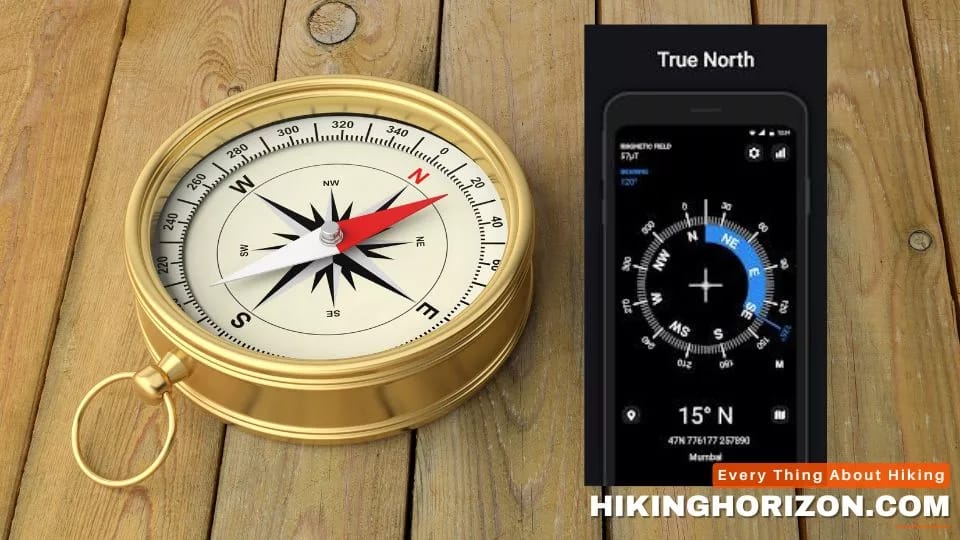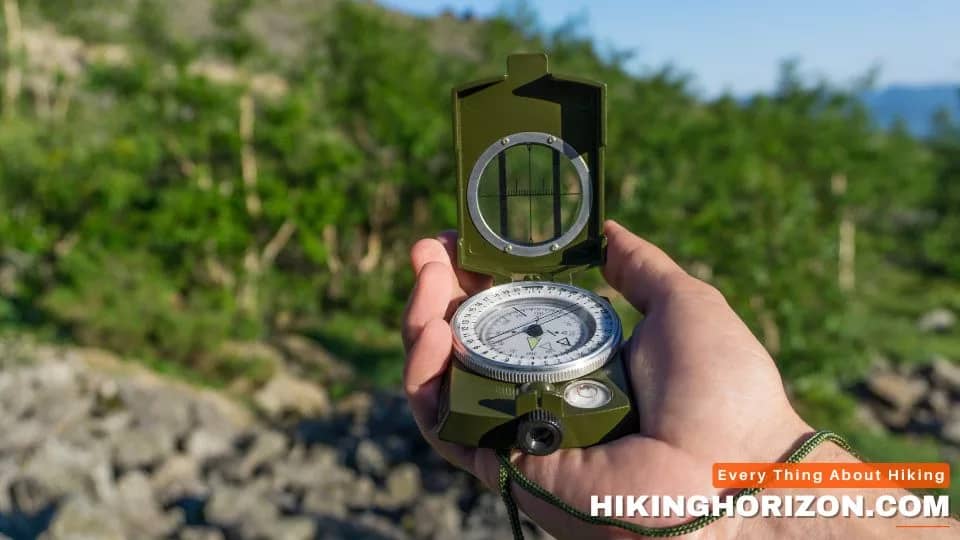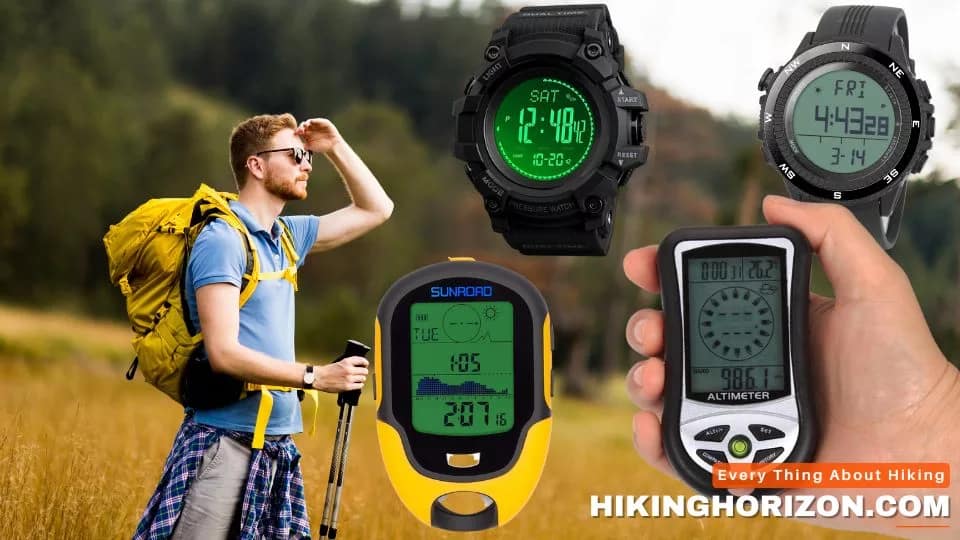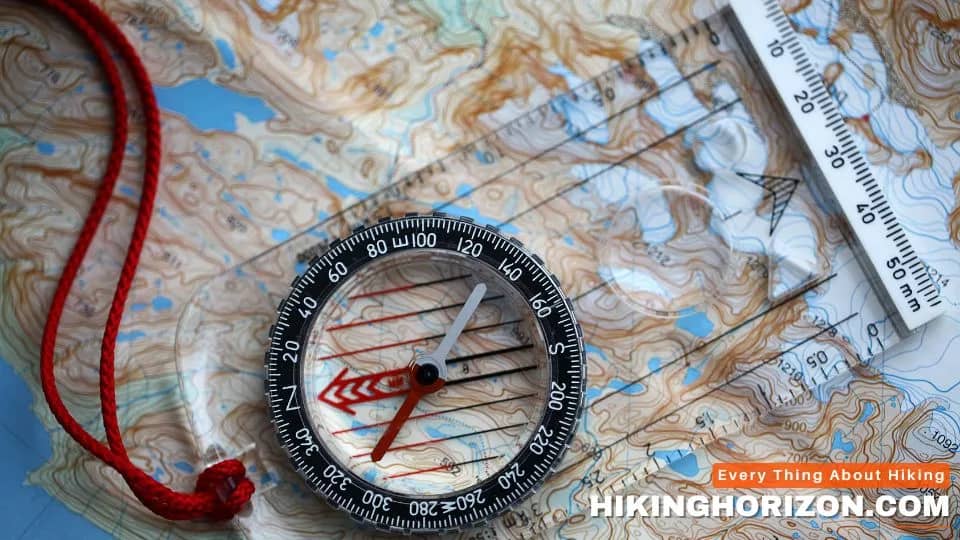
Not having a compass or GPS can make navigating the wilderness incredibly challenging. However, with a bit of knowledge about the Sun, stars, and nature, you can find your way even without these helpful tools. Learning techniques for finding direction without a compass is a valuable skill for any outdoor enthusiast.
This article will explore the many methods expert hikers use to determine cardinal directions when they find themselves without modern navigation aids deep in the wilderness. From using analog watches and the stars to reading the landscape around you, we’ll cover 11 ingenious ways how to find direction without a compass. After learning these valuable ways, you can fine North, West, East, and West without any compass.
Table of Contents

#1 Use the Sun to find Direction without a compass
One of the simplest ways to find direction without a compass during the day is to use the Sun’s position in the sky. Here’s how it works:
- In the northern hemisphere, the Sun ascends from the eastern horizon and descends beyond the western horizon. Around noon, when the Sun reaches its zenith in the sky, it is approximately positioned to the south.
- In the southern hemisphere, this is reversed – the Sun rises in the east and sets in the west, but at noon it’s roughly in the North.
So, in the northern hemisphere, if you stand facing the rising Sun, the east is on your right, and the west is on your left. When facing the setting sun, the west is on your right, and the east is on your left.
To find north and south, find a stick about 3 feet long and stick it vertically into the ground. Mark the tip of the stick’s shadow with a stone. Wait 15 minutes, then mark the new position of the shadow’s tip. Draw an imaginary line connecting the two marks through the stick – this line runs roughly east-west. The perpendicular line runs roughly north-south.
Pro tip
Increase accuracy by marking and connecting the stick’s shadow tips over an hour rather than just 15 minutes.
“When lost in the wilderness, the sun can be your best compass – if you know how to use it.” – Bear Grylls, survival expert.
#2 Use An Analog Watch To Find cardinal directions Without A Compass
You can find north and south with an analog watch by creating an improvised compass. Here’s how to do it:
- Point the hour hand at the Sun.
- Locate the midway point between the hour hand and the 12 o’clock position.
- Draw an imaginary line from that midpoint through the center of the watch. This line points south.
- The opposite direction points north.
This method works in both the northern and southern hemispheres. Just be sure your watch is set to the correct time.
Pro tip
If you don’t have a watch, you can estimate the time based on the Sun’s position. Always remember that the Sun ascends from the eastern horizon and descends in the western skies.
“In the wilderness, a compass may fail, but a well-tuned internal clock will always guide you.” – Mykel Hawke, U.S. Army Special Forces veteran.
#3 Stars Tell Direction Without A Compass ─ oldest way to navigate
Finding the North Star is one of the most reliable ways to determine direction in the night sky.
- Locate the Big Dipper constellation.
- Draw an imaginary line following the “pointer” stars at the outer edge of the cup towards the first bright star you see.
- This star is Polaris, the North Star. It sits almost motionless in the sky, directly above the North Pole.
So, if you face the North Star, North is directly in front of you. You can then deduce south, east, and west.
The North Star appears higher in the northern sky and lower in the southern sky. It can be tricky to find in the southern hemisphere as it skims along the northern horizon.
Pro Tip
Download a star-gazing app to help identify constellations if you can access a smartphone.
“On the darkest nights, the stars light the clearest path.” – Matshona Dhliwayo, philosopher.
#4 North Star's "Pointers" ─ way to find the north star

Finding Polaris directly can be difficult, but locating its “pointer” stars in the Big Dipper and Little Dipper makes it easier.
The two stars at the front of the Big Dipper’s “bowl” point up towards Polaris. Draw an imaginary line connecting these stars and extend it upwards – Polaris will be 5 times the distance between the pointer stars.
For the Little Dipper, trace a line connecting the outer two stars of the cup – these points right to Polaris.
Pro tip
Download a night sky app and practice finding the Dippers and North Star from different perspectives and times before heading into the wilderness.
“The stars are the street lights of eternity.” – Dejan Stojanovic.
#5 Navigation Using The Crescent Moon
A crescent moon can also help you determine cardinal directions:
- Find the crescent moon low in the western sky after sunset or high in the eastern sky before sunrise.
- Imagine a line running from the horns of the crescent through its middle.
- Extend this line downward to the horizon – it will point south.
This method works no matter which phase the moon is in. Just visualize the line connecting the tips of the crescent.
Pro tip
If the moon is high overhead, projecting the crescent line downward is difficult. Move to a location where the moon appears nearer the horizon.
#6 Observe Moss on trees To Find North without a compass
Moss can also reveal north and south directions:
- In the northern hemisphere, you’ll often find moss flourishing on the northern side of trees and rocks.
- In the southern hemisphere, moss favors the south side.
It is because these sides get less direct sunlight and are more moist.
So, if you’re lost in a forest, look for moss growing heavily on one side of a tree. Head the opposite way to walk north (or south in the southern hemisphere).
Pro tip
Determine your hemisphere first to know which side moss growth indicates north or south.
“There is life in the old girl yet. Like moss creeping north over the stones.” ― Annie Proulx, The Shipping News
#7 Navigate By Wind Direction

Wind patterns can also help you deduce direction:
- Prevailing winds at mid-latitudes generally blow from the west.
- In the tropics, trade winds stem from the northeast (northern hemisphere) and southeast (southern hemisphere).
So, if you feel a steady breeze from the west, you can assume the North is on your left (in the northern hemisphere).
Pro tip
Watch rising smoke to confirm wind patterns. Smoke rising straight up indicates still air.
“Fill your lungs with the wind and fight the current. Row until you can’t see the shore.” ― Christopher McCandless, Into the Wild.
#8 Using The Cardinal Directions ─ The Art Of Navigating Without A Compass
Beyond individual techniques, wilderness experts recommend tuning into the landscape to develop an innate sense of direction without a compass. Notice cardinal directions from natural cues:
- North-facing slopes receive less sunlight, so they are cooler and moist. South facing are drier and warmer.
- East-facing slopes get morning light, while west-facing slopes see evening sun.
- Rivers often flow south and east, seeking the ocean. Lakes gather in northern regions.
- Trees often bend and lean south/southeast under prevailing winds.
- Morning fog gathers in eastern valleys; western valleys see evening fog.
Observing these patterns repeatedly builds an intuitive sense of orientation.
Pro tip
Study area maps and familiarize yourself with the terrain before going back to the country.
“My compass comes not from geography or science, but from a sense of direction encoded in my very nature.” – Jim Harrison.
#9 Make an Improvised Sundial to Find North
With minimal supplies, you can make a basic sundial and use it to find North:
- Place a long stick vertically in the ground.
- Mark the end of the stick’s shadow with a stone and note the time.
- Do this every 15 minutes, rotating around the stick.
- Draw lines connecting the stones through the stick’s base – these indicate east, south, west, and North.
You now have an improvised compass! Follow the north line to orient yourself.
Pro tip
Make your sundial on level, open ground for greater accuracy.
“A sundial in the shade can still tell time – if you have the patience to learn its language.” – Matshona Dhliwayo
#10 Construct a Shadow Clock to Find North
A shadow clock provides another way to determine direction:
- Hammer a 3+ foot stick into the ground vertically.
- Mark a circle around it divided into 12 equal segments.
- Note where the tip of the stick’s shadow hits the circle every hour.
- Draw a line connecting the morning and afternoon marks through the stick, indicating east-west.
The perpendicular line shows north-south. Align yourself to these axes to orient north.
Pro tip
Mark more times of the day to increase accuracy. Make sure your “clock” is on flat, open ground.
#11 Follow Shifting Constellations Through the Night

The night sky revolves around the North Star for over 12 hours. Stars rise in the east and set in the west, just like the Sun. Tracking these motions can help navigate:
- Orion rises in the east around 8 p.m. and sets around 8 a.m.
- Ursa Major (Big Dipper) rotates counterclockwise around the North Star over 12 hours.
- Cassiopeia makes a “W” low in the northern sky early evening, becoming an “M” high overhead around midnight.
Observing such patterns provides a sense of direction and time throughout the night.
Pro tip
Study star charts for your latitude to know what constellations are visible and where they rise and set.
“At night I lie awake, staring at the sky and its innumerable stars, and I wonder where you are.” – Tenessee Williams.
key takeaway: how to Find direction Without a Compass

Though challenging at first, navigating by nature gets easier with practice. Mastering even just a few of these methods can give you the confidence to explore the trail, knowing you can find your way back in case you get lost. The key is being attentive to the landscape and heavens around you.
As wilderness expert Mykel Hawke says, “Trust your senses. The world is your compass, if you know how to navigate her.”
So next time you hit the backcountry without a compass, remember:
- Use the Sun to find east, south, west, and North.
- Convert an analog watch into a makeshift compass.
- Locate the North Star using pointer stars in the Big and Little Dipper.
- Follow the crescent moon’s orientation to deduce south.
- Let moss patterns show you which way is North.
- Note wind and weather tendencies for clues about direction.
- Make sundials and shadow clocks to track the Sun across the sky.
- Observe shifting constellations throughout the night.
Creativity and awareness allow you to master wayfinding even without modern navigation tools. The wilderness provides many guides if you know what to look for.
Learning to Navigate by Nature's Cues
Venturing into the wilderness without a compass may seem daunting, but this guide offers numerous methods for determining direction by observing nature’s signals. For example, you can use this method of reading moss growth to find north – scanning the side of trees to see where moss tends to grow can reveal if you’re facing north or south, depending on what hemisphere you’re in. Other techniques include locating the North Star at night by finding the Big Dipper constellation, whose outer edge points the way. During the day, the Sun’s orientation can illuminate one direction. Paying attention to landscape features like slopes, valleys, and waterways also provides clues for navigating without a compass.
With practice, anyone can become adept at wayfinding by unlocking nature’s secrets. Learn to spot Polaris in the night sky, either high overhead or lower on the horizon, depending on your latitude. Note how constellations like Orion appear to have moved across the heavens over the course of the night. Determine direction by using an analog watch’s hour hand to deduce north and south. Let the wilderness become your compass by getting in tune with patterns of light, landscape, and life. Before long, you’ll develop an innate sense of orientation to find your way through the wilds.
Frequently Asked Questions (FAQs)
What is the easiest way to find north during the day?
Using the Sun’s location is the simplest method. In the northern hemisphere, face the rising Sun; east will be on your right, and west on your left. At noon, when the Sun is highest, it’s roughly to the south. It is reversed in the southern hemisphere.
How can you find south at night?
Locate the crescent moon low in the western sky after sunset or high in the eastern sky before sunrise. Imagine a line running from the horns through the middle and extending it downwards – it points toward the south.
What direction does moss grow on trees?
In the northern hemisphere, moss favors the north side of trees and rocks. In the southern hemisphere, it grows predominantly on the south side. Head the opposite way of the moss growth to walk north.
Can you use the stars to navigate?
Yes, locating the North Star is an accurate way to determine your cardinal directions at night. Find the “pointer” stars in the Big and Little Dipper constellations – these point toward Polaris, which sits fixed above the North Pole.
How do you find North using an analog watch?
Point the hour hand at the Sun, then find the midpoint between it and 12 o’clock. The imaginary line from there through the watch’s center points south. Facing the opposite way reveals north.
What are some natural navigational clues?
Observe north and south-facing slopes, prevailing wind direction, how waterways bend, where fog gathers, and patterns in vegetation and tree growth. These can provide an innate sense of direction.
Can you make your own compass with basic supplies?
Yes, you can make improvised sundials and shadow clocks using sticks and rocks to track the Sun’s path across the sky, revealing east, west, north, and south.
How do you navigate by the stars?
Learn constellations like the Big Dipper that rotate around the fixed North Star. Watch stars rise in the east and set in the west as the night progresses. Apps can help identify star patterns.
Why is finding the north important?
Determining North helps you deduce the other cardinal directions – east, south, and west. It provides a starting point for navigation using the Sun, moon, stars, or landscape cues when you don’t have a compass.
What should you do if you are totally lost without a compass?
Stop moving and look for shelter and water first. Then, observe the Sun, moon, and stars to attempt to orient yourself. Review maps to identify surrounding landmarks if possible. Making signal fires and staying put aids search and rescue.
Conclusion: Master the Art of Wayfinding
Determining direction without a compass requires patience, imagination, and learning to truly observe your surroundings. But with practice, you can master the art of wayfinding using the Sun, moon, stars, and nature’s signals.
Next time you venture into the wilderness, challenge yourself to put down the GPS and tap into your innate sense of orientation. Face north by the Sun’s location. Find the halfway point to the Sun and draw a north-south line. Mark the [north-south line] made by a stick’s shifting shadow over an hour. With attention and imagination, you can use these methods to determine direction without a compass.
Navigating by the stars connects us to generations past who crossed oceans guided only by the night sky. Locate the North Star using the two stars that form the outer edge of the Big Dipper’s cup. This star to find your direction has been used for centuries.
Observe the sides of trees carpeted in moss, pointing you to the south (or North, depending on your hemisphere). Notice how the landscape orients itself around the cardinal directions – valleys and slopes, prevailing winds, and waterways, all providing clues for navigating without a compass.
Mastering wayfinding transforms your perspective. The wilderness becomes your compass, an intimate guide leading you through its hidden contours. So open your senses and learn the land’s language. Let it direct you one star, Sun, and stream at a time.

SARAH LEE
Sarah has been hiking for over five years and is passionate about promoting the mental and emotional benefits of spending time in nature. She has written several articles on the topic and strongly advocates hiking as a form of therapy. Sarah is also a certified yoga instructor, often incorporating yoga and mindfulness practices into her hiking trips. She is dedicated to providing accurate and up-to-date information on trail conditions, difficulty levels, and must-see sights.

SARAH LEE
Sarah has been hiking for over five years and is passionate about promoting the mental and emotional benefits of spending time in nature. She has written several articles on the topic and strongly advocates hiking as a form of therapy. Sarah is also a certified yoga instructor, often incorporating yoga and mindfulness practices into her hiking trips. She is dedicated to providing accurate and up-to-date information on trail conditions, difficulty levels, and must-see sights.



